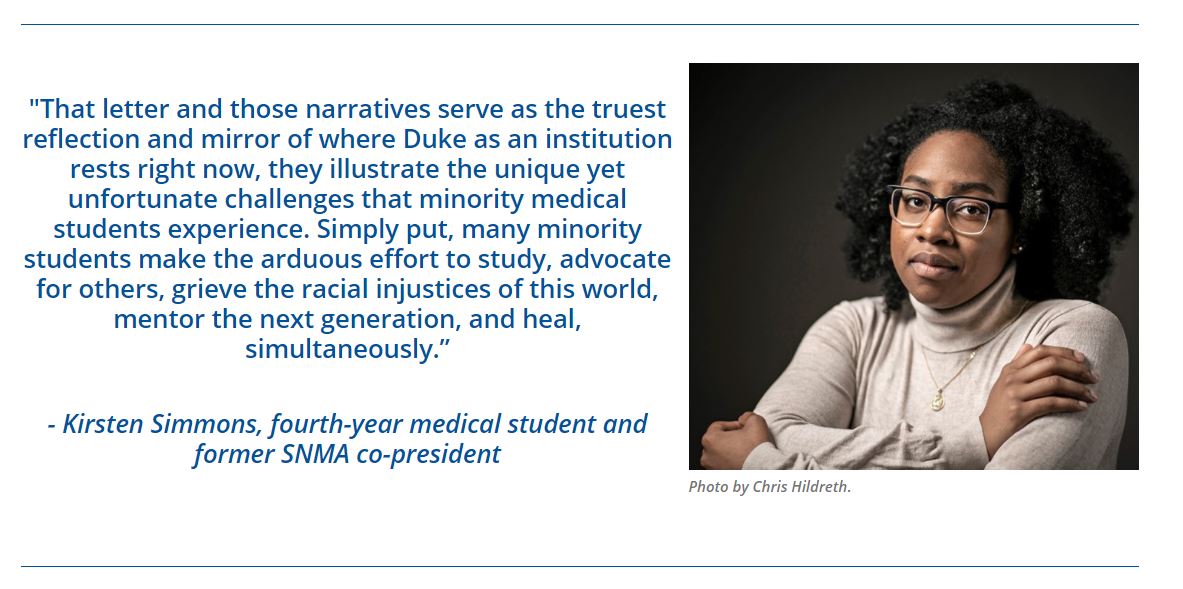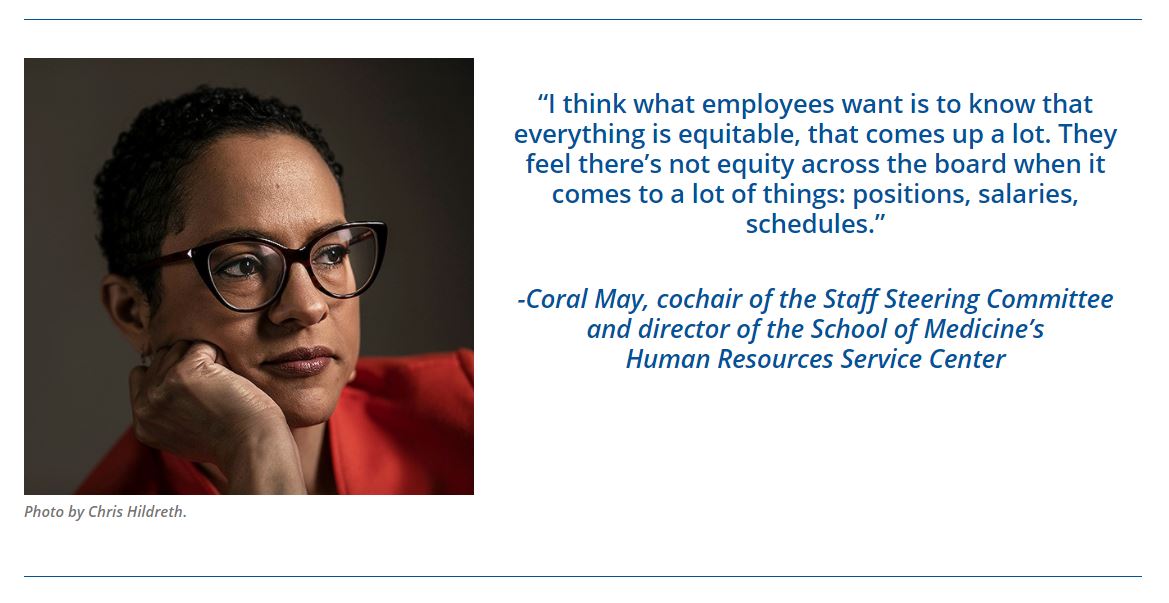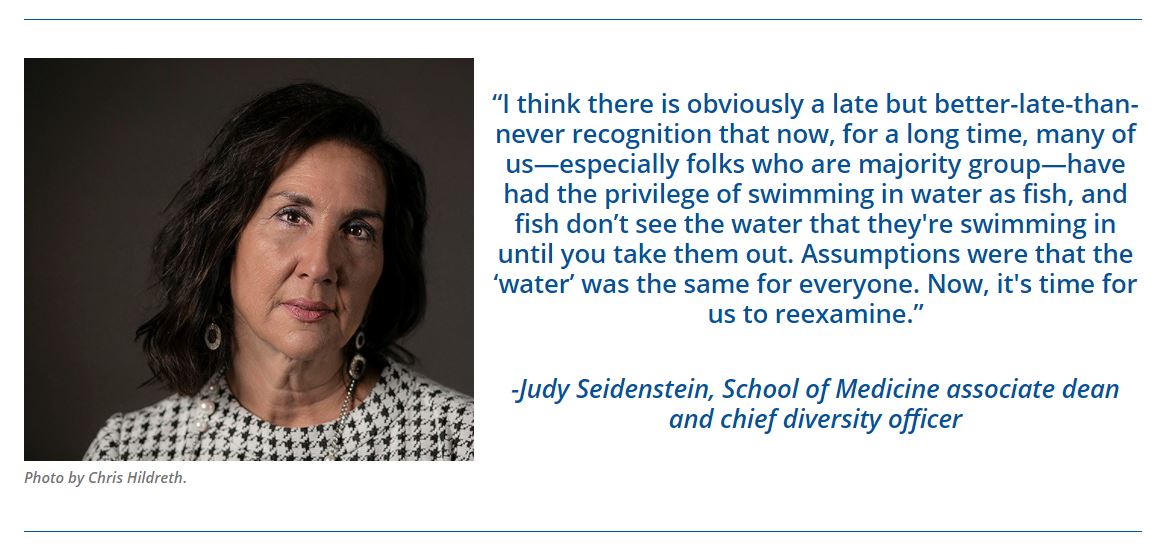
'Say their names.'
That’s the call made by many in reference to the numerous Black people who have been killed by police or civilian vigilantes in this country. It’s a call that some say represents the long-overdue need to address systemic racism in the U.S. And it’s a call that many students, faculty, and staff say must include Duke University School of Medicine.
Spurred by the killings of George Floyd, Ahmaud Arbery, Breonna Taylor, Rayshard Brooks, and others, the School of Medicine, along with other schools across Duke and throughout the country, has made a commitment to heed the call to eliminate racism and take a stand against racial injustice. Further driving that commitment is the COVID-19 pandemic, which has disproportionately affected racial and ethnic minority communities. Both structural racism and the pandemic have been deemed public health crises.
Beginning with the School of Medicine’s “Turning a Moment into a Movement: Dismantling Racism” event hosted in June by Dean Mary E. Klotman, BS’76, MD’80, HS’80-’85, the summer of 2020 was filled with events like Duke Health’s Walk for Solidarity (part of the national “White Coats for Black Lives” movement), panel discussions, and listening sessions with often uncomfortable but meaningful conversations that Klotman and other leaders say they plan to continue for a long time and hope will lead to change.
“We have only begun the process,” Klotman says. “It will take time to address this deep-rooted, complex problem.”
MOVING FROM A MOMENT
Every year, Klotman delivers a State of the School address that typically includes highlights of the past academic year and plans for the coming one. This year, George Floyd’s death on May 25 thrust racism and racial injustice into the forefront of conversations and triggered worldwide protests. The events prompted Klotman to focus the State of the School solely on race in a virtual event that featured frank talk about the realities and challenges of racial discrimination.
“I can think of nothing more important to talk about at this moment than our need to acknowledge and to take the essential steps to dismantle any structural racism within our institution,” she said during the event. “When we do that, we can become powerful, credible champions of change outside the walls of Duke.”
The event featured a panel made up of faculty members and one student who shared their personal stories of racism and offered their thoughts on how the School of Medicine can address systemic racism and health disparities.
Even before the “Turning a Moment into a Movement” event came about, students in the medical, physical therapy, physician assistant, and graduate programs voiced their concerns and called for change. The conversations triggered by the students helped inform the content of the event.
In June, students from the Duke chapter of the Student National Medical Association (SNMA) presented the dean with a letter including a list of recommendations to bring about equity in the school. Members of the student-run organization, which focuses on supporting minority medical students, expressed disappointment in the school’s delayed response in addressing police violence and affirming support of Black students. The letter also included seven pages of student narratives, which anonymously shared their painful experiences with racism, ongoing grief, and sense of isolation at Duke.
Students described situations in which their intelligence was questioned due to the color of their skin, or when they were subjected to racist remarks by patients that providers failed to address.

STRATEGIC PLANS
Shortly after the June event, the school officially launched a strategic planning process with the goal of dismantling racism in the school and surrounding communities and addressing the associated inequities and injustices.
As a part of the process, the school formed four steering committees that are working to identify key issues and opportunities. Made up of two cochairs and 10 to 15 members, each committee represents one of the school’s main constituencies: health professions students, graduate students and postdocs, faculty, and staff. There is also an oversight committee of approximately 20 representatives who will help integrate all of the committees’ findings, prioritize recommendations, and address any gaps. Dozens of other individuals within the School of Medicine have also been involved through subcommittee participation, surveys, focus groups, and interviews.
The committee cochairs and others involved in the strategic planning process are quick to point out that while they are energized and enthusiastic about coming up with ideas and recommendations, the work will take time, and there will be no overnight solutions.
“It’s not just a pen-and-paper thought exercise,” says Judy Seidenstein, the school’s associate dean and chief diversity officer. “It’s not a situation where you fill out a template and get this done by said deadline. It is personal, it is heartfelt, it is thoughtful, and it is deliberate.”
She adds that the committees are taking this opportunity to “engage all the key people whose voices have long been unheard, have been silenced, and have been on mute.”

“As staff members at Duke, we want our voices heard and to know that we have a say,” adds Betsy Hames, associate dean and chief human resources officer for the School of Medicine, who also serves as cochair of the Staff Steering Committee. “We’re fortunate to work at a university like Duke, where most people are really open to the ideas of others. The time just seems right for this, while there’s a lot of momentum.”
May and Hames are hopeful that in addition to offering staff the opportunity to have their voices heard, their work will also lead to change. Their committee is focused on a number of issues, including training and recruitment. All of the committees are reviewing those issues along with a number of others, including the curriculum, mentorship, retention, promotion, representation, and diversity.
A DEEPER DIVE INTO DIVERSITY
Kevin Thomas, MD, HS’99-’07, who is cochair of the Faculty Steering Committee and assistant dean for underrepresented faculty, says the work of the four committees is a daunting task. A major part of their work is the collection and analysis of data. The committees are reviewing data from institutional surveys, focus groups, exit interviews, and testimonials captured from faculty and students to inform recommendations for school transformation.
The Faculty Steering Committee has gathered race and ethnicity data on faculty representation, promotion, and attrition. The committee has also looked at data from previous focus groups conducted in 2017 and exit interviews from racial and ethnic minority faculty who have left Duke since 2016. Additionally, they asked faculty to share personal stories to help the committee better understand the challenges that exist.

In 2018, the School of Medicine conducted the Association of American Medical Colleges (AAMC) Diversity Engagement Survey, which assessed perceptions of inclusion and engagement among faculty, staff, and students. The survey provides a range of insights into the inclusivity of the environment as well as diversity across the school.
One concern is low diversity among faculty and school leaders. Recent figures on the composition of School of Medicine regular-rank faculty reveal that currently 4.3 percent are Black/African American and 3.6 percent identify as Hispanic/Latino. Klotman says this low diversity speaks to a dearth of mentors, role models, and thought leaders from these identity and demographic groups. “We need to examine why we have not had more success, examine the root cause, and then address how we change going forward,” she says.
Though the planning process has just begun, the committees have been empowered to make a few decisions that the school can act upon now. One such decision was to pause the nomination process for Duke’s chapter of the Alpha Omega Alpha Medical Honor Society until an appointed committee can agree on how to move forward with an equitable selection process. Members of the SNMA and other students have questioned why the society isn’t more diverse at Duke.
On September 1, the School of Medicine, along with other schools at Duke, submitted an initial report summarizing actions to date in the planning process to Duke University President Vincent Price. This summer, President Price requested those reports as part of the university’s sweeping commitment to anti-racism and social justice. Dean Klotman and committee cochairs from the School of Medicine emphasize that the work is emotional and complex, and they plan to take the time necessary to come up with well-considered solutions for lasting change.
AN IMPACT THAT LASTS
The cochairs admit that this type of work isn’t new. The school has made efforts to advance racial equity and inclusion in years past, from creating programs such as the Teaching for Equity Fellowship to making the Cultural Determinants of Health and Health Disparities course a requirement for first- and second-year medical students. But the groundswell of energy and attention sparked by the killings of Floyd, Arbery, Taylor, and other Black Americans provides an impetus to build on earlier efforts and formulate crucial next steps.

For this work to have a lasting impact, the steering committees have made it a priority to focus on sustainability. Thomas says accountability of leadership is one way to make sure any work the School of Medicine does is long-lasting. He says financial investment is critical as well.
“Whether it’s endowments or philanthropy specifically dedicated to issues around dismantling racism, equity, promoting health equity, and diversity and inclusion, unless we establish the financial stream that will continue to provide long-term inputs into this, then it won’t sustain,” Thomas says.
Ultimately, the aim of the school’s efforts is to create a more diverse, inclusive, and just institution for all and to better prepare current and future doctors and medical leaders to serve diverse communities.
“Having clinicians who represent the perspectives of the patients that we take care of is critical to the mission,” says Thomas. “Having researchers who are from different racial and ethnic backgrounds focused on health disparities research brings an element to our research portfolio that could be expanded with opportunities to innovate and lead. Fostering an inclusive environment and appointing leaders who have different ideas and different life experiences will enrich the culture and elevate things that we do well.”
This article first appeared in the DukeMed Alumni News Fall 2020 issue.